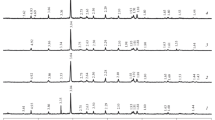Abstract
The physical and technological properties of the 3D construction printing material are formulated. It is shown that the composition should have unique rheological characteristics, controlled setting time, high adhesion, and fast strength. It is determined that a similar material with the required properties can be obtained by creating a composite material based on two active substances: a cementing material and a polymer binder, on one hand, and modification of the particles surface with a superplasticizer, on the other hand. The regularities of the influence of organic components (polymer binder and oligomeric superplasticizer) on the cement matrix are obtained. The mortar mobility, setting time, strength characteristics, and microstructure of the polymer–cement mortar are investigated. A patented composition of the composite material is developed for the innovative construction industry based on Portland cement and polyvinyl acetate dispersion. By modifying the phase boundary of the colloidal system, the proposed composite has the required plastic strength, high setting rate, high fast strength, crack resistance, and a number of other properties necessary for 3D printing of large-sized products and off-formwork structures.







Similar content being viewed by others
REFERENCES
Xi-Qiang, L., Jing-Fang, L., Tao, Z., Liang, H., Nan, Z., Juan, L., and Guoyou, L., CN Patent 104310918A, 2014.
Tianrong, Y. and Qiaoling, L., CN Patent 104891891A, 2015.
Peng, F. and Xinmiao, M., CN Patent 104309126A, 2014.
Fu-Cai, L., Yi-Yuan, W., Min, X., Bin, L., Xin-Zhen, Z., and Ming, H., CN Patent 104961411A, 2015.
Vatin, N., Chumadova, L., Goncharov, I., Zykova, V., Karpenya, A., Kim, A., and Finashenkov, E., 3D printing in building industry, Stroit. Unikal’nykh Zdanii Sooruzh., 2017, no. 1 (52), pp. 27–46.
Lloret, E., Shahab, A.R., Linus, M., et al., Complex concrete structures Merging existing casting techniques with digital fabrication, Comput.-Aided Des., 2015, vol. 60, pp. 40–49.
Lim, S., Buswell, RA., Le, T.T., et al., Developments in construction-scale additive manufacturing processes, Autom. Constr., 2012, vol. 21, no. 1, pp. 262–268.
Roussel, N., A thixotropy model for fresh fluid concretes: theory, validation and applications, Cem. Concr. Res., 2006, vol. 36, no. 10, pp. 1797–1806.
Poluektova, V.A., Shapovalov, N.A., and Evtushenko, E.I., Nano-modified polymer solution for additive technologies, Int. J. Pharm. Technol., 2016, vol. 8, no. 4, pp. 24930–24937.
Poluektova, V.A., Shapovalov, N.A., and Vladykin, V.N., From nano-scale to macrostructure in composite for additive technologies, Proc. Int. Conf. “Actual Issues of Mechanical Engineering (AIME 2017),” Amsterdam: Atlantis Press, 2017, pp. 614–619.
Can Touch, Construction mixes for the 3D printer. http://specavia.pro/catalog/stroitelnye-smesi-dlja-3dprintera/.
Idea-Z, Some aspects of printing on building S series 3D printers. http://specavia.pro/articls/2238/.
APIS-KOR technical report. http://apis-cor.com/ files/ApisCor_presentation.pdf.
APIS-KOR technical solutions. http://apis-cor.com/ files/ApisCor_TechnicalSolutions_RU.pdf.
Ohama, Y., Handbook of Polymer-Modified Concrete and Mortars, Amsterdam: Elsevier, 1995.
Popov, K.N., Polimernye i polimertsementnye betony, rastvory i mastiki (Polymeric and Polymer-Cement Concretes, Mortars, and Mastics), Moscow: Vysshaya Shkola, 1987.
Poluektova, V.A., Slyusar’, A.A., and Shapovalov, N.A., Superplastifikator na osnove floroglyutsinfurfurol’nykh oligomerov dlya vodnykh mineral’nykh suspenzii (Superplasticizer Based on Phloroglucinofurfural Oligomers for Water Mineral Dispersions), Belgorod: Belgorod. Gos. Tekhnol. Univ., 2012.
Poluektova, V.A., Shapovalov, N.A., Chernikov, R.O., and Evtushenko, E.I., RF Patent 2661970, 2018.
Rekomendatsii po fiziko-khimicheskomu kontrolyu sostava i kachestva superplastifikatora S-3 (Recommendations for the Physicochemical Control of the Composition and Quality of Superplasticizer S-3), Moscow: Nauchno-Issled., Proektn.-Konstr. Tekhnol. Inst. Betona Zhelezobetona, 1984.
Ramachandran, V.S., Concrete Admixtures Handbook: Properties, Science, and Technology, Amsterdam: Elsevier, 1983.
Shapovalov, N.A., Poluektova, V.A., Ponomarev, F.Yu., and Chernikov, R.O., RF Inventor’s Certificate no. 20160014, 2016.
Author information
Authors and Affiliations
Corresponding author
Additional information
Translated by A. Kolemesin
Rights and permissions
About this article
Cite this article
Poluektova, V.A. Designing the Composition of a Cement-Based 3D Construction Printing Material. Inorg. Mater. Appl. Res. 11, 1013–1019 (2020). https://doi.org/10.1134/S2075113320050263
Received:
Revised:
Accepted:
Published:
Issue Date:
DOI: https://doi.org/10.1134/S2075113320050263




